As the New Financial Year starts we get reminders for Tax via our phone or through the tax men, the chartered accountant or the employer, that it is the season to plan your taxes. And your reaction would be like, again, emptying your pockets for the government that doesn’t take care of your needs!
Now think of a World that is Tax-Free. Let’s be honest. We all have fantasized about living in a world like this. But Taaadddaahhhhh lets come to reality!!!!!!!!

Apart from the fact that taxes are viewed as a financial burden, what could further add to the stress could be a lack of knowledge about tax planning. A majority of us struggle with fitting in the tax-save puzzle. Perhaps, it is high time we should start teaching taxes to students while they are still in school so that they can get prepared for this not-so-fancy term.
So the first Question for you all, What is Tax-saving and the Income Tax Act?
The Income Tax Act came into effect in 1961. Everything pertaining to the imposition, collection, recovery, and administration of income taxes falls under the purview of the Income Tax Act.
As a taxpayer, you may have multiple sources of income during your life. According to the Income Tax 1961, your earnings or profits in a given financial year attract taxes.
Whether you are a salaried individual or an entrepreneur, or whether you make a rental income, or earn an income from your investments, you have to pay taxes to the government.
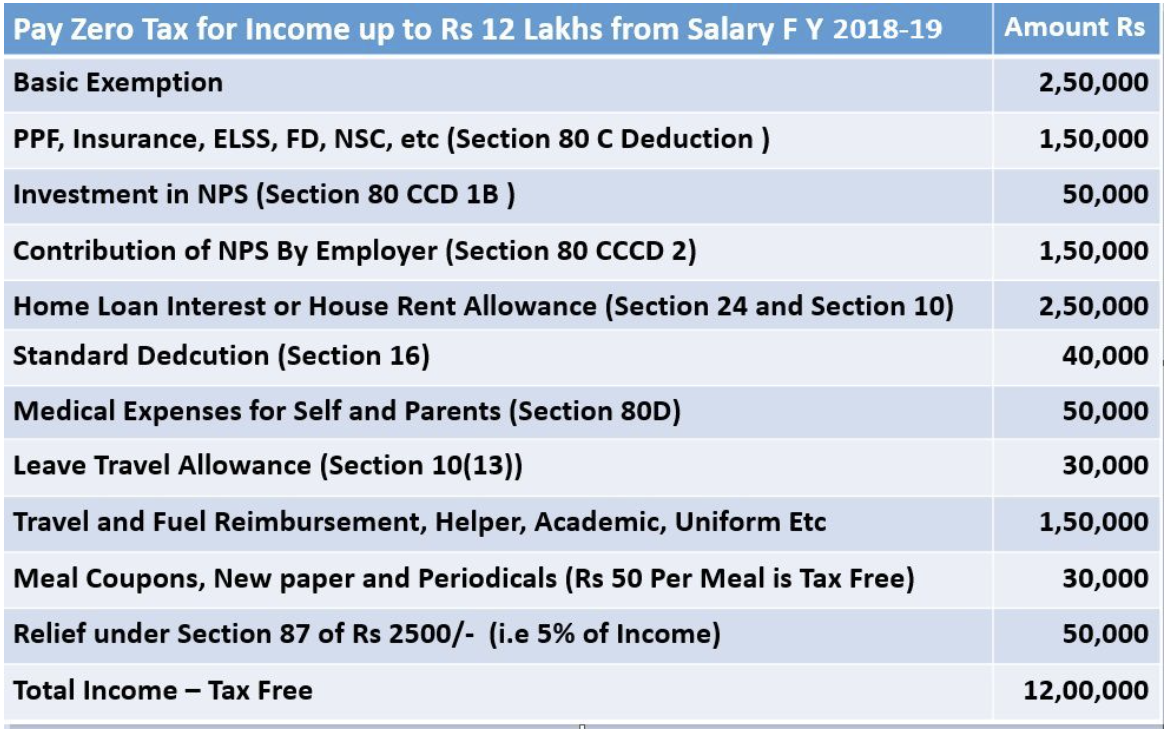
To help you in this regard, Section 80C, 80D, and 80G of the Income Tax Act list the ways you can save on taxes. If you are confused on how to plan your finances for maximum tax benefits, here are a few recommendations based on your risk appetite:
- High-risk appetite: If you are an aggressive investor and you are looking for high returns in addition to tax benefits under Section 80C, you can consider investing a total of ₹1.5 lakh per year in Equity Linked Saving Schemes (ELSS). This is a tax-saving mutual fund that has the potential to offer double-digit returns. In other words, you can avail tax benefits in the short term and earn good returns in the long term.
- Moderate risk appetite: If you have a moderate risk appetite, you can invest a portion of your money in ELSS and the rest in Public Provident Fund (PPF) and/or tax-saving fixed deposits. This strategy gives you the required tax benefits under Section 80C and also helps you balance your risk and returns.
- Low-risk appetite: If you are totally risk-averse, you can invest in saving fixed deposits or PPF. Here, you avail the same tax deduction of ₹1.5 lakh under Section 80C and the risk exposure on these avenues is minimal.
But, while these avenues offer you fixed returns, the rate of return can be quite low (just between 6-8%). This can be a problem if you take inflation into consideration. Education inflation, for instance, is around 10-12% every year. This means, if you invest in PPF for long-term goals like your child’s education, you may not be able to achieve your goals.
These investments can help you save a maximum of ₹46,800 on taxes every year by making these investments.
If you are still confused, no worries! By using free tools like the ET Money Income Tax calculator. you can easily save on your taxes.
Some Additional benefits beyond Section 80C
If you want deductions over and above the limit as specified under Section 80C, you can invest in the National Pension Scheme on the Atal Pension Yojana. Section 80CCD (1B) of the Income Tax Act gives deductions of up to ₹50,000 for contributions towards these schemes. As a taxpayer, you can save up to ₹15,600 under this section.
You can also claim tax benefits for premiums paid towards health insurance for self, spouse, children, and parents and term insurance plans. This benefit comes under Section 80D of the Income Tax Act. Every year, you can save up to ₹15,600 on these health insurance payments.
Overall, the combination of these options can help you save up to ₹78,000 every year. This is a considerable amount of money.
How can you save up to ₹78,000 a year?
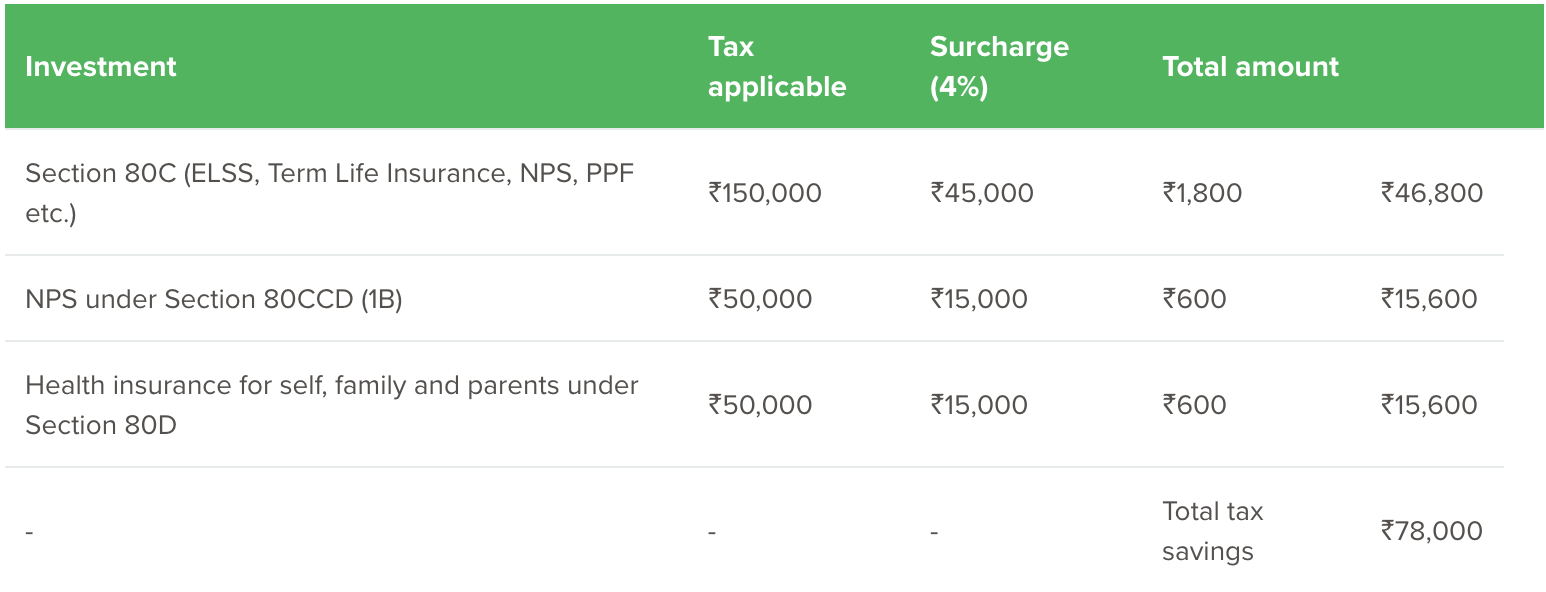
What is Section 80C?
Section 80C of the Income Tax Act 1961, reduces your tax liabilities by allowing deductions from your total taxable income in a financial year.
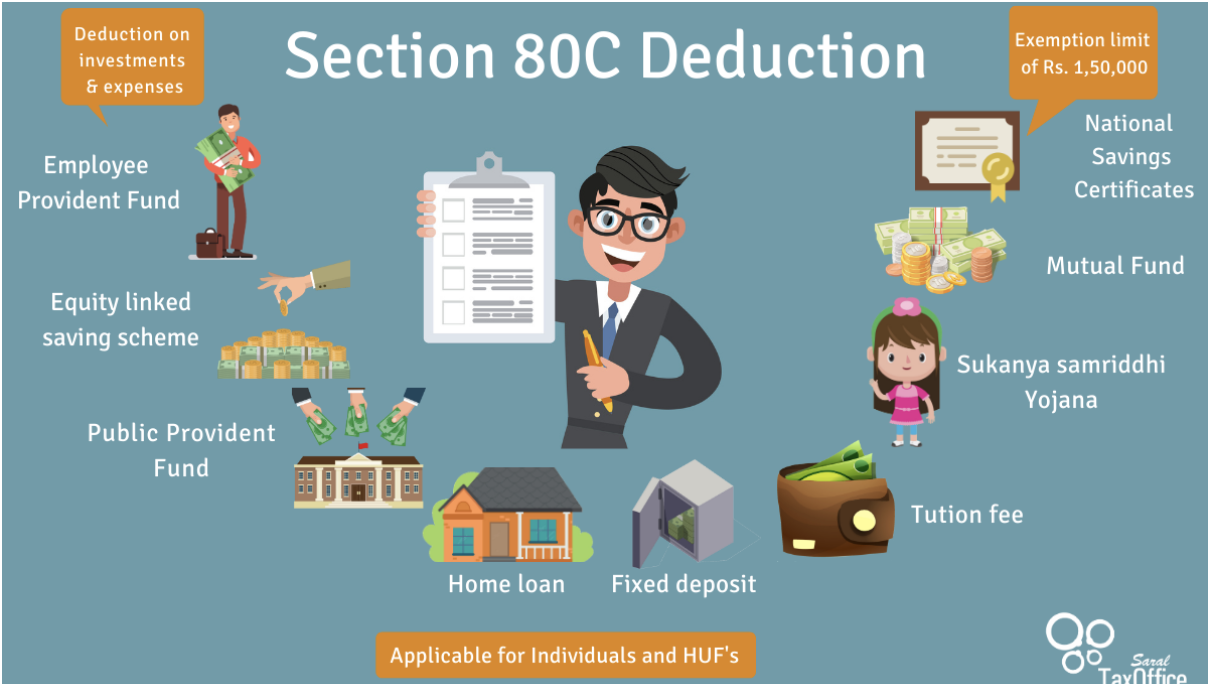
According to Section 80C of the Income Tax Act 1961, taxpayers can claim deduction benefits on any investments, contributions, or payments towards financial products and schemes as stipulated by the Income Tax law. Section 80C came into effect on April 1, 2006, as a replacement for the older Section 88. Currently, the maximum deduction allowed under Section 80C is ₹1,50,000 in a financial year. Earlier, until FY 2014-15, the limit was ₹1,00,000.
Then there is an Equity Linked Savings Scheme which is a type of mutual fund with a lock-in period of three years. It is the only mutual fund category in India, which qualifies for a tax deduction under Section 80(C) of the Income Tax Act. Investments are primarily made in equity markets, thus generating significantly higher returns than other tax-savings schemes in the long run. You can either choose to invest a lump sum amount or take the SIP (Systematic Investment Plan) route. However, you cannot withdraw your money before the three-year lock-in is over. Since these mutual funds invest in the stock markets, they could carry moderately high risk. However, the risk factor gets evened out in the long run, making it one of the most profitable tax-saving investments. In terms of taxes on returns, on the gains from your ELSS investments exceeding ₹1 lakh in a financial year, you have to pay an LTCG tax of 10%. If you want to earn decent returns and can stay invested in the long run, ELSS investments can be an excellent venture.
ELSS has the shortest lock-in and highest returns among all tax-saving options. And you can also escape LTCG taxes if you harvest it smartly.
You can also plan for Senior Citizen Savings Scheme; this comes in the scene when you are already retired or applying for voluntary retirement; the Senior Citizens Savings Scheme can be an option as a risk-free tax-saving investment. It is a long-term savings option backed by the Indian government. The maturity period is five years and investors can seek an extension by an additional three years. The current interest rate is 8.6%, and you can only opt for a premature withdrawal after a year of opening the account. If you close your account before two years, 1.5% of the deposit is deducted as a penalty. The interest is taxable, and TDS is applicable in case the interest exceeds ₹10,000 per annum. With an SCSS account, you can be assured of a regular income in your post-retirement years.
Then you can plan for National Pension System, which is a retirement benefit plan, administered and regulated by the Pension Regulatory Fund Authority of India. If you subscribe to the NPS, your money will be invested primarily in equity and debt instruments, and the value of the investment at maturity will depend on the performance of these asset classes. Currently, equity exposure is capped in the range of 50% to 75% and is limited to 50% for government employees. You can either decide how much money gets invested in each asset class or opt for an age-based asset allocation model. On attaining the age of 60, you can only withdraw 60% of the maturity amount; the remaining 40% is used to purchase an annuity to help you receive a pension. Premature withdrawals of up to 25% are only allowed after three years.
NPS is the cheapest equity investment product there is.
You can get linked to Term Life insurance premiums. It can allow you to avail tax deductions under Section 80C. Premiums paid to ensure self, spouse, dependent children and any member of Hindu Undivided Family are eligible. If the policy has been issued on or before March 31, 2012, the annual premium up to 20% of the assured sum becomes tax-deductible. For insurance policies issued on or after April 1, 2012, 10% of the sum assured is tax-deductible. A life insurance policy will provide your family financial support in case of your untimely death and should be taken by everyone. The tax benefit is an added perk. Choose a life insurance plan appropriate for you and your family. It is important not to view insurance cover only as a way to save taxes.
HERO OF MIDDLE CLASS is Public Provident Fund, which is a long-term investment option through which you can also avail tax benefits. The current rate of interest on a PPF account is 7.9% p.a., compounded annually, and the lock-in period is 15 years. This means you have to stay invested for 15 years, although partial withdrawals are allowed from the seventh year. You can open an account with as little as ₹100. The minimum and maximum investments allowed in a financial year are ₹500 and ₹1.5 lakh, respectively. In case your annual investment exceeds ₹1.5 lakh, interest cannot be earned on the excess amount. You will have to make at least one deposit a year for 15 years. PPF is regarded as a safe tax-saving investment avenue. You do not have to pay any taxes on the deposit or interest at the time of withdrawal.
Government allows you to move entire PPF corpus to NPS and enjoy better returns and flexibility.
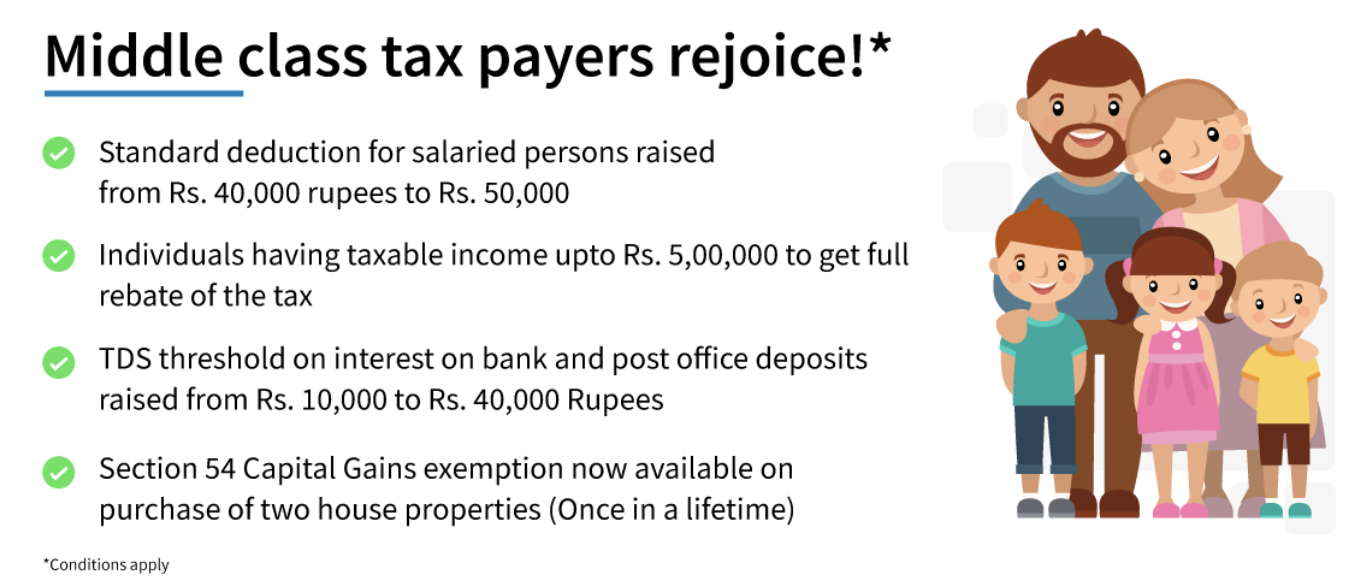
You can also opt for National Savings Certificates. It is a fixed-income investment offered by the Government of India. You can invest in this scheme by visiting a post office near you. The lock-in is five years, and the current interest rate is 7.9% per annum. The minimum amount required to purchase an NSC certificate is ₹100. Certificates are available in denominations of ₹10,000, ₹5,000, ₹1,000, ₹500, and ₹100. Premature withdrawals are only allowed if the certificate holder has passed away, or if the certificates have been forfeited. The scheme is safe as it is backed by the Government of India which ensures the safety of your capital. Also, only the interest earned in the final year is taxed.
Try on Tax-saving FDs where you can invest in tax-saving fixed deposits and claim maximum tax deductions of up to ₹1.5 lakh. The interest rate you get is what the prevailing 5 year FD rate is and the lock-in period is five years, which means you can’t take out the money before five years. You can only make a one-time lump sum deposit, while premature withdrawals are not allowed. The minimum investment amount varies depending on your bank, but the maximum amount is capped at the 80C limit, i.e. ₹150,000. You can either reinvest the interest or opt for monthly or quarterly payouts. TDS is applicable on the interest earned on your FD, but you can avoid it by submitting Form 15G or Form 15H (in case you are a senior citizen) to the bank.
Tax saving FDs provide just enough returns to beat inflation. So, technically your wealth gain are negligible.
- Home loan repayment: If you have taken a home loan, the part of EMI that goes towards repaying the principal amount is eligible for tax deductions under Section 80C. The amount you pay as interest does not qualify for tax deductions under this section.
- Tuition fees: You can claim tax deductions up to ₹1.5 lakh on tuition fees paid for your child’s education. This benefit is only available to individual parents or guardians and a maximum of two children per individual. The deduction does not depend on the class of the child. However, it must be a full-time education course in an Indian school, college or university. Parents of adopted children, unmarried individuals and divorced parents can also claim these benefits.
What is Section 80CCD?
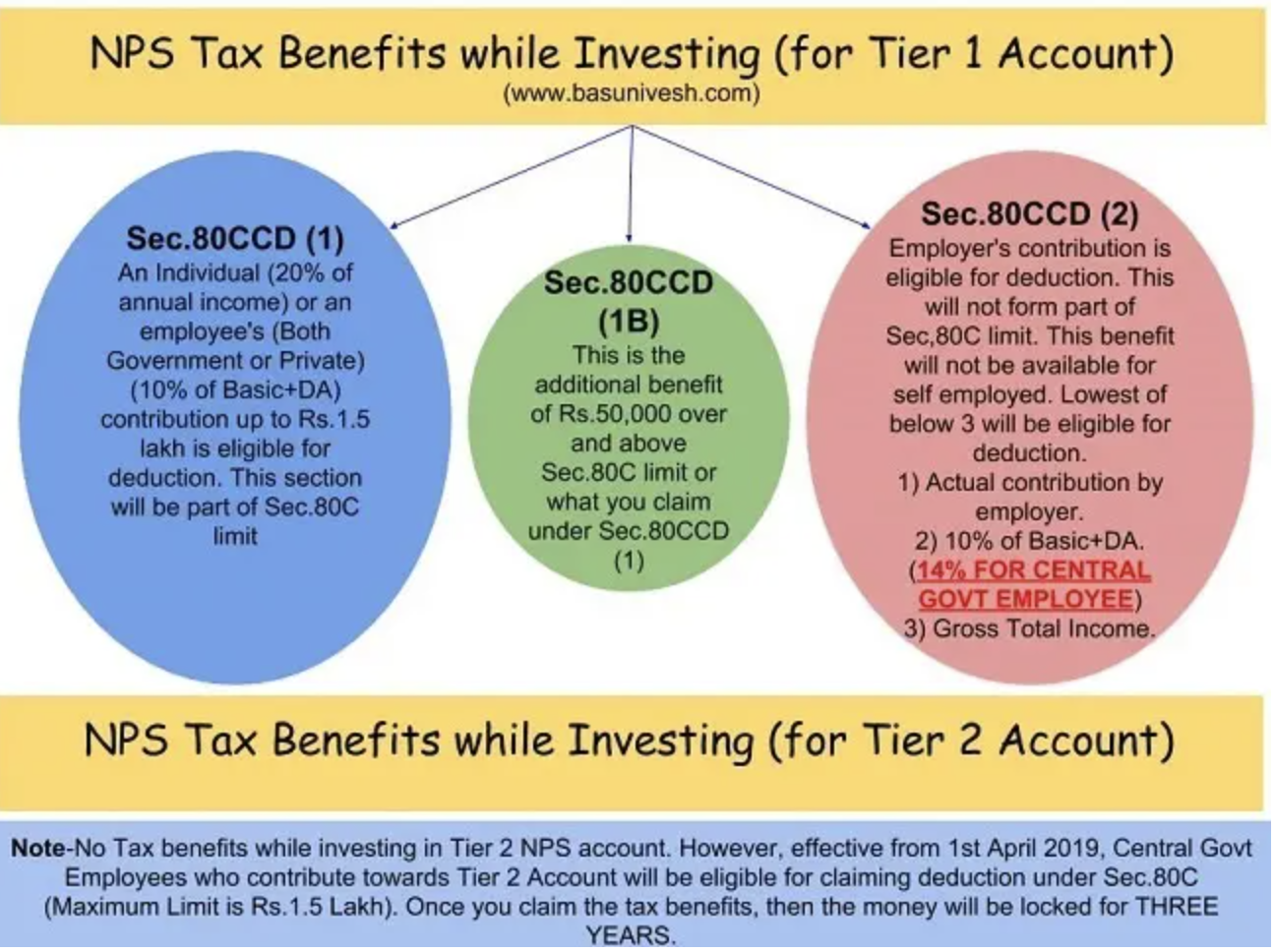
Section 80CCD discusses the tax deductions available to taxpayers regarding investments in the National Pension System (NPS). There are two subsections here:
- Section 80CCD (1): Investments in NPS are eligible for tax deductions under this section. Any Indian citizen between the age of 18 and 60 years can invest in NPS and avail this tax benefit. Even NRIs can claim this benefit. The maximum deduction you can avail of under this section is 10% of your salary (this includes basic salary + DA). For self-employed individuals, the limit is 20% of their gross total income.
Also, the maximum benefit you can avail of every year under this section is ₹1.5 lakh.
- Section 80CCD (1b): This subsection provides an additional deduction of ₹50,000 on investments in NPS. This is over and above the ₹1.5 lakh available under Section 80CCD(1). So, in short, you can avail a total tax deduction of ₹2 lakh when you invest in NPS every year.
What is Section 80D?
Under Section 80D of the Income Tax Act, you can claim deductions up to ₹1 lakh for contributions towards medical insurance premiums bought for insuring self, spouse, children and parents. . The deductions under 80D are over and above the exemptions, you can claim under Section 80C. This benefit can be claimed by individuals and Hindu Undivided Families (HUFs).
If you file your taxes as an individual, you can claim deductions for insuring yourself and your family. In addition:
- You can claim a maximum deduction of ₹25,000 in a financial year on the health insurance premium for self and family, i.e., spouse, parents and children.
- If you are a senior citizen, you can claim a maximum deduction of ₹50,000 per financial year.
- Here are the provisions for premiums bought for medical insurance for parents.
- If your parents are less than 60 years of age, you can claim a maximum deduction of ₹25,000 per year on their health insurance premiums bought on their behalf.
- If they are senior citizens, the maximum deduction allowed is ₹50,000 in a financial year.
Overall, if you purchase a life insurance policy for your family as well as your parents (and your parents are below the age of 60), you can claim a maximum tax deduction of ₹50,000. But if you and your parents are above the age of 60, you can avail of a maximum deduction of ₹1 lakh under Section 80D.
What is Section 80E?
Under Section 80E of the Income Tax Act, the amount you spend in repaying the interest on your education loan can qualify as a deduction from your total income.
The loan should have been taken for the education of self, spouse, children, or a student for whom you are the legal guardian, and should have been taken from a bank or an approved financial institution.
The total amount paid in repaying the loan interest in a financial year is regarded as the deduction amount and there is no cap on the maximum amount you can claim as a deduction. You will have to acquire a certificate from the bank that differentiates the principal from the interest component of the education loan you have repaid.
What is Section 80EE?
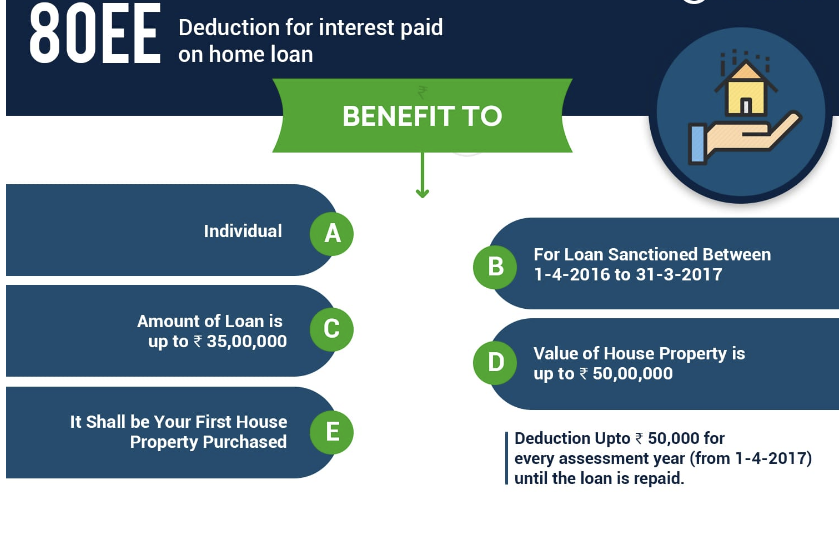 Section 80EE of the Income Tax Act, 1961 allows a tax deduction benefit on the interest paid on home loans taken by a first-time homebuyer. If you fall into this category, you can claim a tax deduction of up to ₹50,000 under section 80EE. This deduction limit is over and above the limit provided under section 80C and Section 24 of the IT Act, 1961.
Section 80EE of the Income Tax Act, 1961 allows a tax deduction benefit on the interest paid on home loans taken by a first-time homebuyer. If you fall into this category, you can claim a tax deduction of up to ₹50,000 under section 80EE. This deduction limit is over and above the limit provided under section 80C and Section 24 of the IT Act, 1961.
As a taxpayer, you need to satisfy the following conditions to be eligible to claim this deduction.
- You should not own any other residential property on the date of the sanction of the loan.
- The value of the house should be less than ₹50 lakh. The loan must not be availed for a commercial property.
- The loan amount needs to be less than ₹35 lakh.
- The deduction is only available on the interest portion of the loan.
- You do not necessarily have to reside in that property to be eligible.
What is Section 80G?
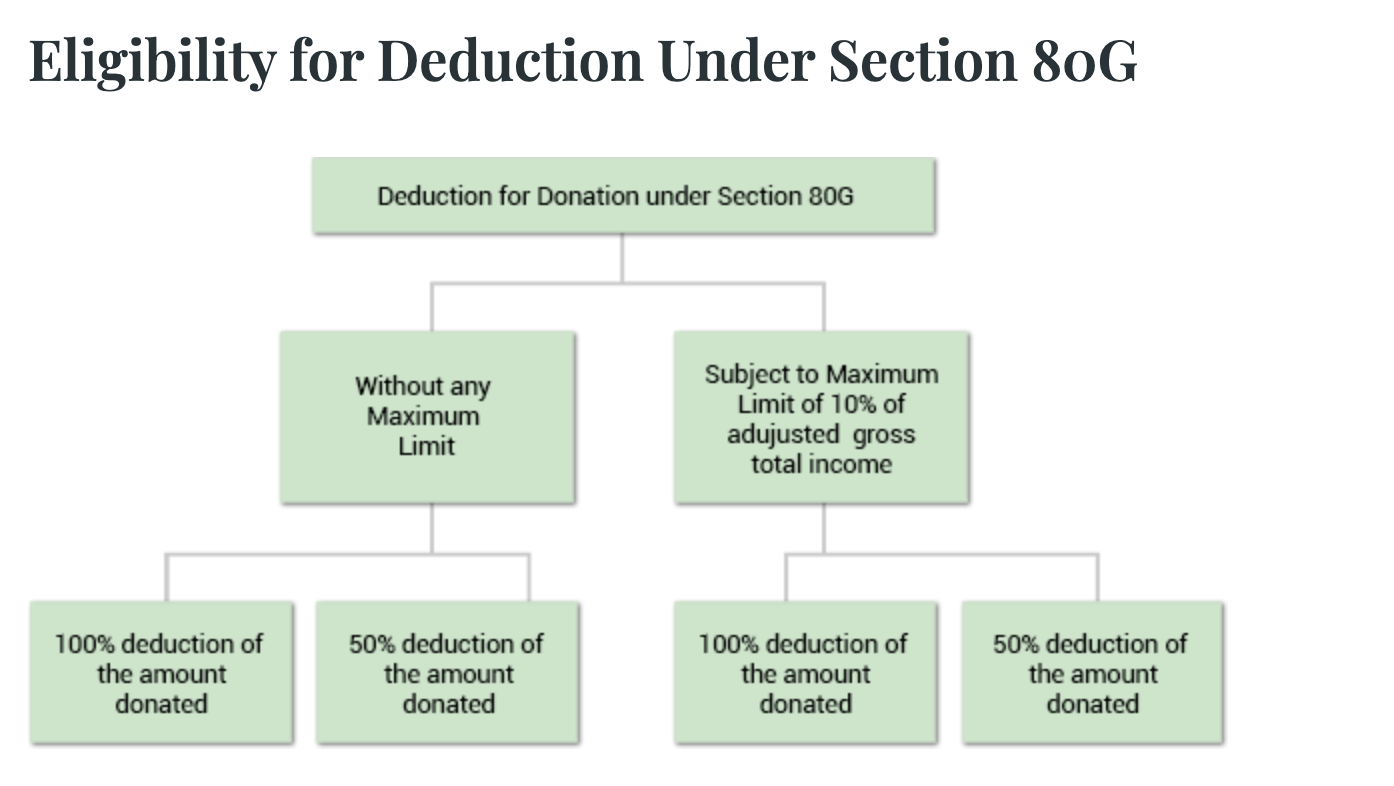
Charity begins at home, but did you know that if you widen the scope of your charitable acts, it can help you save taxes? Section 80G of the Income Tax Act allows you to claim tax deductions on donations made to charitable organizations.
Only donations made towards charitable institutions registered under Section 12A can qualify for deductions. The donations must have been made through taxable income sources. Only those donations where contributions have been made via cash or cheque or demand draft will be eligible. All taxpayers, including non-resident Indians, are eligible.
Cash donations exceeding ₹2,000 are not allowed as a deduction. For donations above ₹2,000 to qualify as a tax deduction, the contribution has to be made using other modes of payment. The various contributions are eligible for a deduction of up to either 100% or 50%, with or without restriction, under Section 80G.
You can also try for VPF Withdrawal
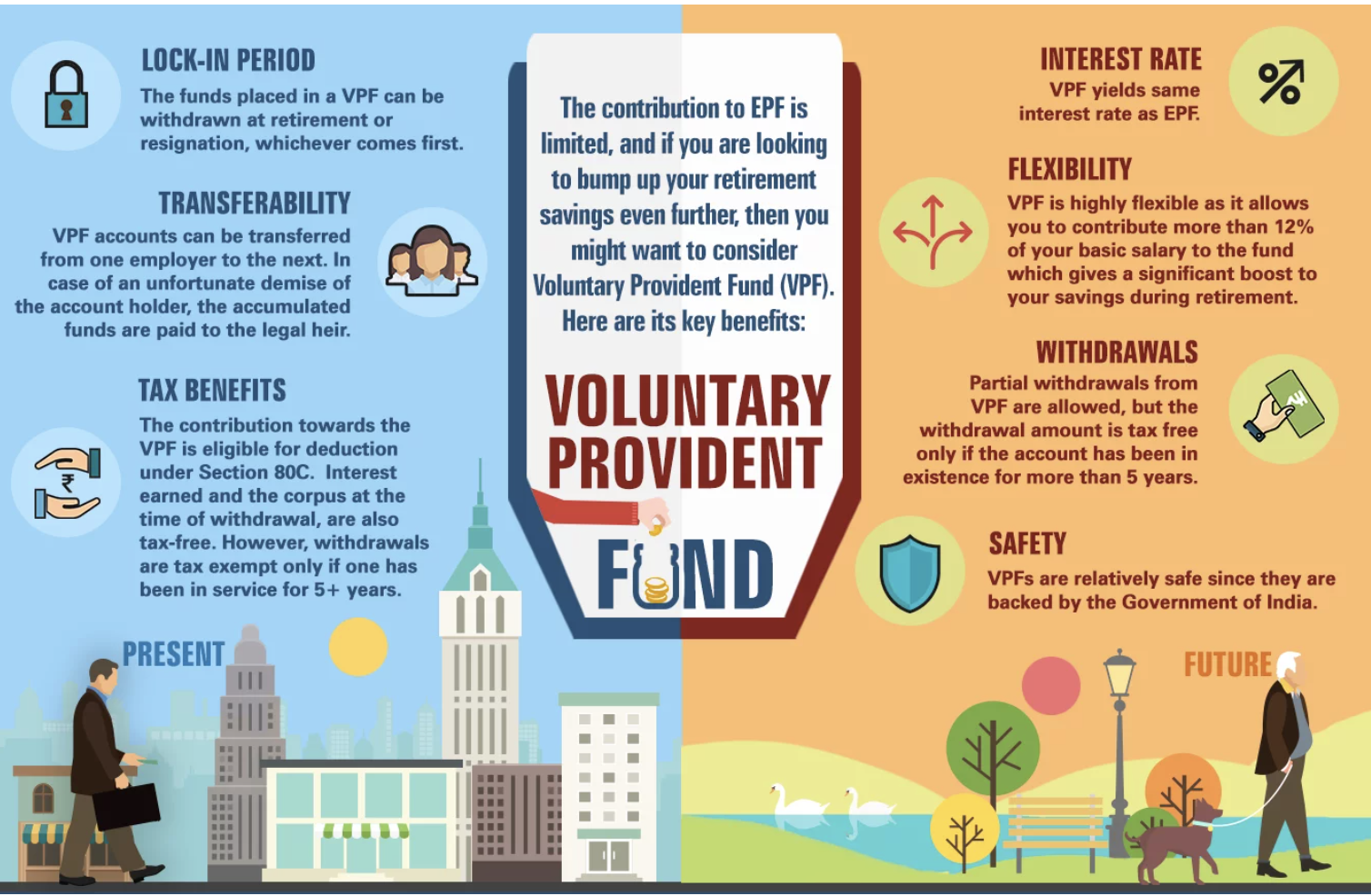
VPF allows partial withdrawals and complete withdrawals. This is a good option to fall back on in case of any unforeseen financial emergencies like paying hospital bills for yourself and/or your family. You can also break your VPF account open for reasons such as:
- Construction or purchase of a new house or a residential plot
- Repayment of an existing home loan
- Higher education or marriage of a child
VPF is quite popular among investors because the accumulated amount can be withdrawn at any point in time. But ensure that your account is active for five years at least if you want to avoid paying tax on the maturity amount.
Always be on the EPFO portal with your UAN Number
The Universal Account Number (UAN) is a 12-digit number, allotted by the Employee Provident Fund Organization to every employee having an EPF account. The UAN remains constant throughout the life of an employee and is portable.
The primary benefit under the UAN is that you do not need to withdraw your EPF when you change jobs. You can transfer your EPF from an old employer to a new one quickly and without hassle. Hence, regardless of the number of times you change your job, you can continue building your EPF corpus without a break.
Then the question arises, What are the Advantages of UAN to Employees?
- You can transfer your EPF balance from an old account to a new one through the UAN.
- Each new PF account with a new job will come under the aegis of a single unified account.
- Whenever you need your PF statement, you can download one instantly – either by logging in using your member ID or UAN or by sending an SMS.
- New employers do not need to validate your profile if the UAN has been Aadhaar and KYC-verified.
- It can be easier to withdraw (fully or partially) EPF online with UAN.
- It is easier for you to ensure that your employer is regularly depositing their contribution in the PF account.
Conclusion of this Whole Discussion
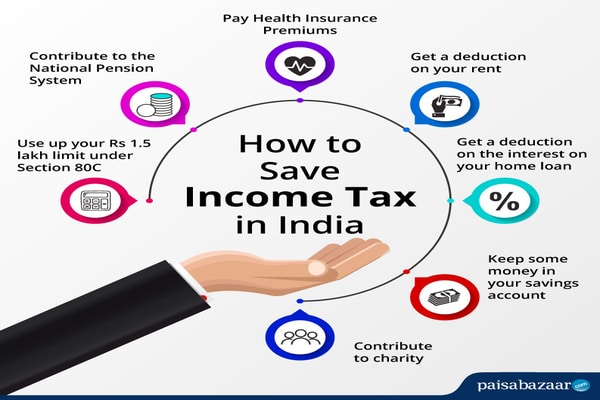
As an employee, you can be assured of a retirement corpus from the EPF scheme. And throughout your career, if you’ve moved jobs, you can be assured of availing the benefits of the provident fund under the same umbrella account, courtesy of the UAN. The VPF (if you choose to invest) provides additional protection and cover.
But on the flip side, EPF has certain limitations. When it comes to investment returns, other retirement saving options like National Pension System (NPS) or Equity Linked Saving Scheme (ELSS) have the potential to earn higher returns. In addition, even VPF comes with restrictions. You can make a full withdrawal from your VPF account only at the time of retirement. This can pose a challenge if you want to meet other financial goals in the short term. A good alternative is to invest in NPS or ELSS if you want inflation-beating returns for your retirement.
An intriguing discussion is worth comment. I do think that you should write more on this topic, it might not be a taboo subject but typically folks dont discuss these issues. To the next! All the best!!